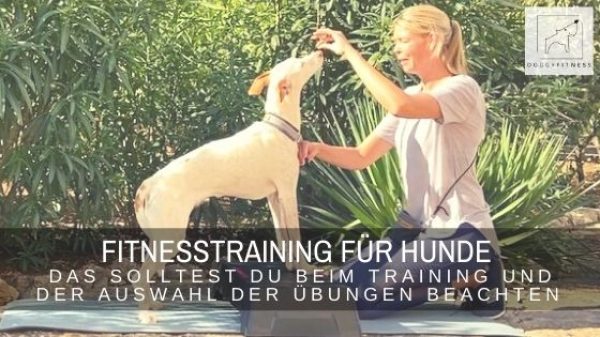Fitness training for dogs is becoming more and more popular. More and more often on the Internet circulate videos of dogs that have mastered the most unusual tricks. In the good faith of dog owners, it is declared as fitness or physical training. The more spectacular, the better – the greater the supposed training effect. Because the dog has to perform really well. Or?! And the more and fancier the equipment, the better the quality of the exercise. Think many. But often the opposite is the case!
But most of the time, he has to do far more than he is actually physically able to do. Or it suits his physical conditions. There you can see quadrupeds struggling to hold on to various training utensils and have to master them in a variety of ways. Often they are absolutely unnatural movements. The dogs move convulsively and unsteadily.
And instead of really training specific movements – to strengthen and improve the body awareness of the dogs. To provide good coordination and balance and strong muscles that stabilize the body. Instead, dogs move in a spasmodic and tense manner, struggling for posture. But how is this actually supposed to create a training effect? How am I supposed to train muscles from a cramped, tense posture? Or a confident body image? This does not work.
Fitness is important
Fitness protects against injuries and lets our dogs manage their daily lives better and safer. But you should always make sure that it is built up in a targeted manner.
Sound fitness and exercise training means building up exercises and the workload slowly, safely and purposefully. Exercises should be judiciously combined and tailored to the physical demands and needs of the dog. Finally, we also do not go to yoga training and start with the advanced course. Quite naturally, we start with the beginner’s course and slowly familiarize our bodies with the movements. Too much ambition is punished with pain and sore muscles. The body reacts. It’s no different with our four-legged friends. And therefore, exercise training to increase physical fitness should always be built with these aspects in mind.
During each exercise, the dog owner should ask himself the following questions:
Why is this exercise good for my dog? Is it even suitable for my dog? What is the aim of the exercises and what is the training effect? How can I build up the exercises slowly and correctly?
If you really want to do something meaningful for your client’s health, then I recommend that you seek advice and instruction from a physical therapist. For the good of your dog’s health. A targeted training program clearly has a greater effect and does more for your dog than random training with the intention of doing something good.
I would like to clear up these fallacies
- You need a lot of equipment to be able to train well. Nope! There is no need for fancy equipment. Many exercises do not require special equipment.
- The more spectacular the exercise looks, the better it works. Nope! Exercises don’t have to look spectacular. Often it is very small, subtle and especially slow movement that has the greatest effect.
- Higher, faster, further – you need a lot of exercises and a lot of repetitions. Also Nope! More exercises and more repetitions do not necessarily bring more. Even just a few coordinated exercises with a fairly small number of repetitions have an exceptionally large training effect. It is the continuity and accuracy (keyword: slow pace) with which the exercises are performed.
So if you see another supposedly unbelievably great exercise that your dog absolutely has to be able to do, I recommend that you first check the exercise for the aspects that I have mentioned.
All the love, your Tina
Fit
nes training for dogs fitness training for fitness training for dogs fitness training for dogs fitness training for dogs fitness training for dogs
Dieser Beitrag ist auch verfügbar auf:
Français (French)
Deutsch (German)
Español (Spanish)
















